Contemporary Business Economics Report: H&M Case Study Analysis
VerifiedAdded on 2022/12/26
|12
|3301
|304
Report
AI Summary
This report provides an in-depth analysis of H&M's business economics, focusing on demand and supply dynamics within the retail sector. The introduction sets the stage by defining business economics and its relevance to H&M, a global fashion retailer. Task 1 delves into the concepts of demand and supply, explaining how these forces influence H&M's market behavior. It examines the factors affecting demand, including price changes and shifts in demand curves, and similarly, the factors influencing supply, such as price and external market forces. The report then progresses to Task 2, which explores emerging theories and models in 21st-century contemporary economics, particularly behavioral economics, and its impact on decision-making. The analysis considers theories such as prospect theory, providing a comprehensive overview of H&M's economic environment and the application of economic principles to a real-world business case.

Contemporary
Business Economics
Business Economics
Paraphrase This Document
Need a fresh take? Get an instant paraphrase of this document with our AI Paraphraser
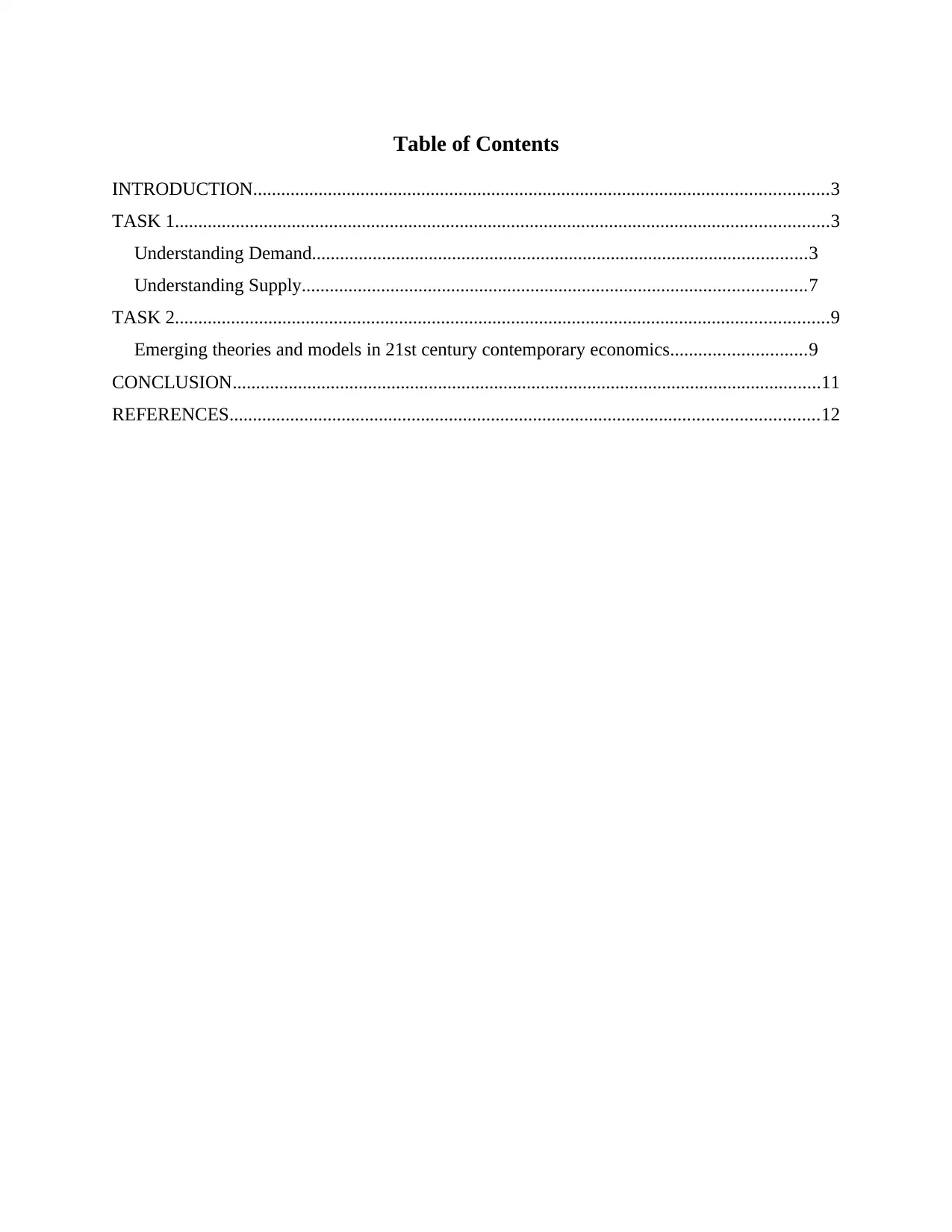
Table of Contents
INTRODUCTION...........................................................................................................................3
TASK 1............................................................................................................................................3
Understanding Demand..........................................................................................................3
Understanding Supply............................................................................................................7
TASK 2............................................................................................................................................9
Emerging theories and models in 21st century contemporary economics.............................9
CONCLUSION..............................................................................................................................11
REFERENCES..............................................................................................................................12
INTRODUCTION...........................................................................................................................3
TASK 1............................................................................................................................................3
Understanding Demand..........................................................................................................3
Understanding Supply............................................................................................................7
TASK 2............................................................................................................................................9
Emerging theories and models in 21st century contemporary economics.............................9
CONCLUSION..............................................................................................................................11
REFERENCES..............................................................................................................................12
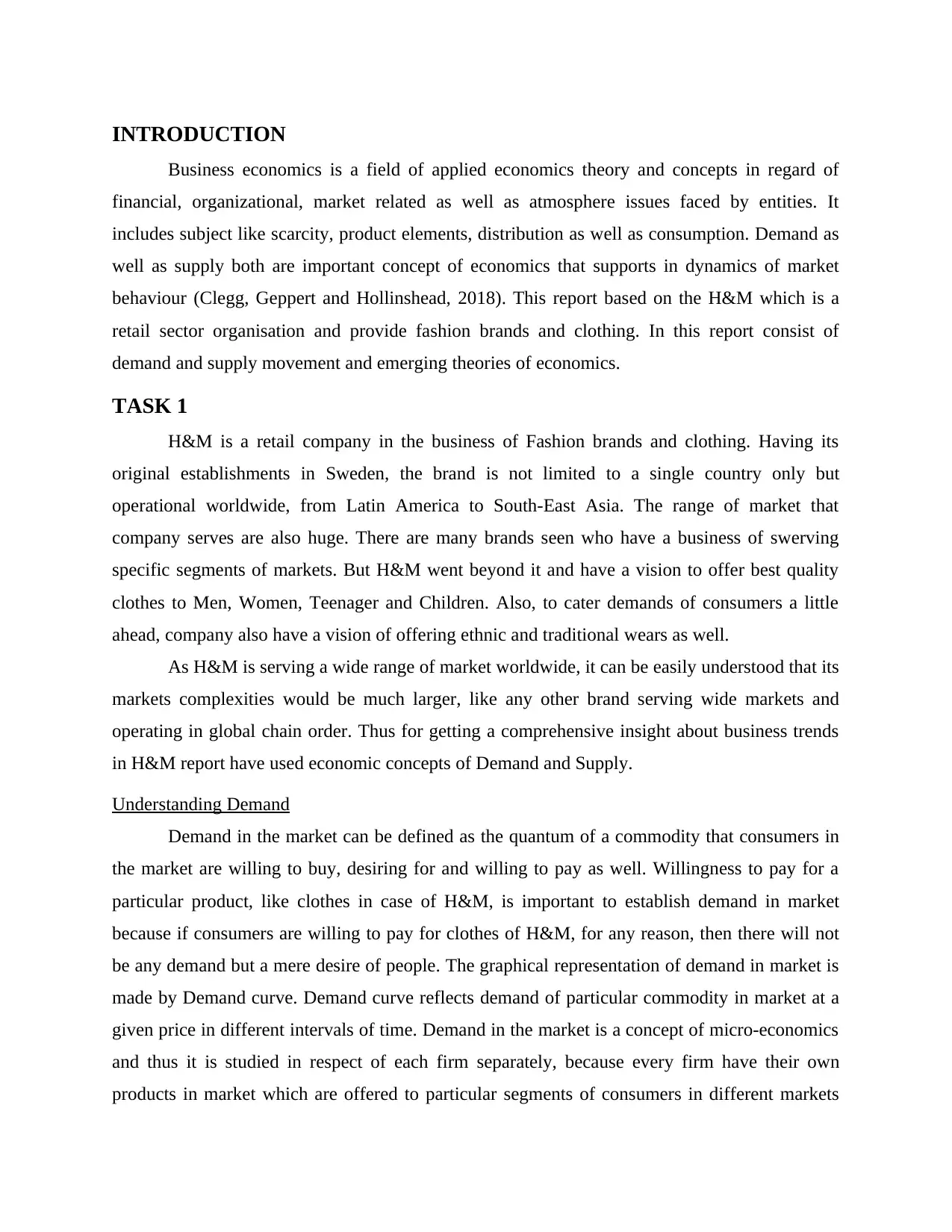
INTRODUCTION
Business economics is a field of applied economics theory and concepts in regard of
financial, organizational, market related as well as atmosphere issues faced by entities. It
includes subject like scarcity, product elements, distribution as well as consumption. Demand as
well as supply both are important concept of economics that supports in dynamics of market
behaviour (Clegg, Geppert and Hollinshead, 2018). This report based on the H&M which is a
retail sector organisation and provide fashion brands and clothing. In this report consist of
demand and supply movement and emerging theories of economics.
TASK 1
H&M is a retail company in the business of Fashion brands and clothing. Having its
original establishments in Sweden, the brand is not limited to a single country only but
operational worldwide, from Latin America to South-East Asia. The range of market that
company serves are also huge. There are many brands seen who have a business of swerving
specific segments of markets. But H&M went beyond it and have a vision to offer best quality
clothes to Men, Women, Teenager and Children. Also, to cater demands of consumers a little
ahead, company also have a vision of offering ethnic and traditional wears as well.
As H&M is serving a wide range of market worldwide, it can be easily understood that its
markets complexities would be much larger, like any other brand serving wide markets and
operating in global chain order. Thus for getting a comprehensive insight about business trends
in H&M report have used economic concepts of Demand and Supply.
Understanding Demand
Demand in the market can be defined as the quantum of a commodity that consumers in
the market are willing to buy, desiring for and willing to pay as well. Willingness to pay for a
particular product, like clothes in case of H&M, is important to establish demand in market
because if consumers are willing to pay for clothes of H&M, for any reason, then there will not
be any demand but a mere desire of people. The graphical representation of demand in market is
made by Demand curve. Demand curve reflects demand of particular commodity in market at a
given price in different intervals of time. Demand in the market is a concept of micro-economics
and thus it is studied in respect of each firm separately, because every firm have their own
products in market which are offered to particular segments of consumers in different markets
Business economics is a field of applied economics theory and concepts in regard of
financial, organizational, market related as well as atmosphere issues faced by entities. It
includes subject like scarcity, product elements, distribution as well as consumption. Demand as
well as supply both are important concept of economics that supports in dynamics of market
behaviour (Clegg, Geppert and Hollinshead, 2018). This report based on the H&M which is a
retail sector organisation and provide fashion brands and clothing. In this report consist of
demand and supply movement and emerging theories of economics.
TASK 1
H&M is a retail company in the business of Fashion brands and clothing. Having its
original establishments in Sweden, the brand is not limited to a single country only but
operational worldwide, from Latin America to South-East Asia. The range of market that
company serves are also huge. There are many brands seen who have a business of swerving
specific segments of markets. But H&M went beyond it and have a vision to offer best quality
clothes to Men, Women, Teenager and Children. Also, to cater demands of consumers a little
ahead, company also have a vision of offering ethnic and traditional wears as well.
As H&M is serving a wide range of market worldwide, it can be easily understood that its
markets complexities would be much larger, like any other brand serving wide markets and
operating in global chain order. Thus for getting a comprehensive insight about business trends
in H&M report have used economic concepts of Demand and Supply.
Understanding Demand
Demand in the market can be defined as the quantum of a commodity that consumers in
the market are willing to buy, desiring for and willing to pay as well. Willingness to pay for a
particular product, like clothes in case of H&M, is important to establish demand in market
because if consumers are willing to pay for clothes of H&M, for any reason, then there will not
be any demand but a mere desire of people. The graphical representation of demand in market is
made by Demand curve. Demand curve reflects demand of particular commodity in market at a
given price in different intervals of time. Demand in the market is a concept of micro-economics
and thus it is studied in respect of each firm separately, because every firm have their own
products in market which are offered to particular segments of consumers in different markets
⊘ This is a preview!⊘
Do you want full access?
Subscribe today to unlock all pages.

Trusted by 1+ million students worldwide
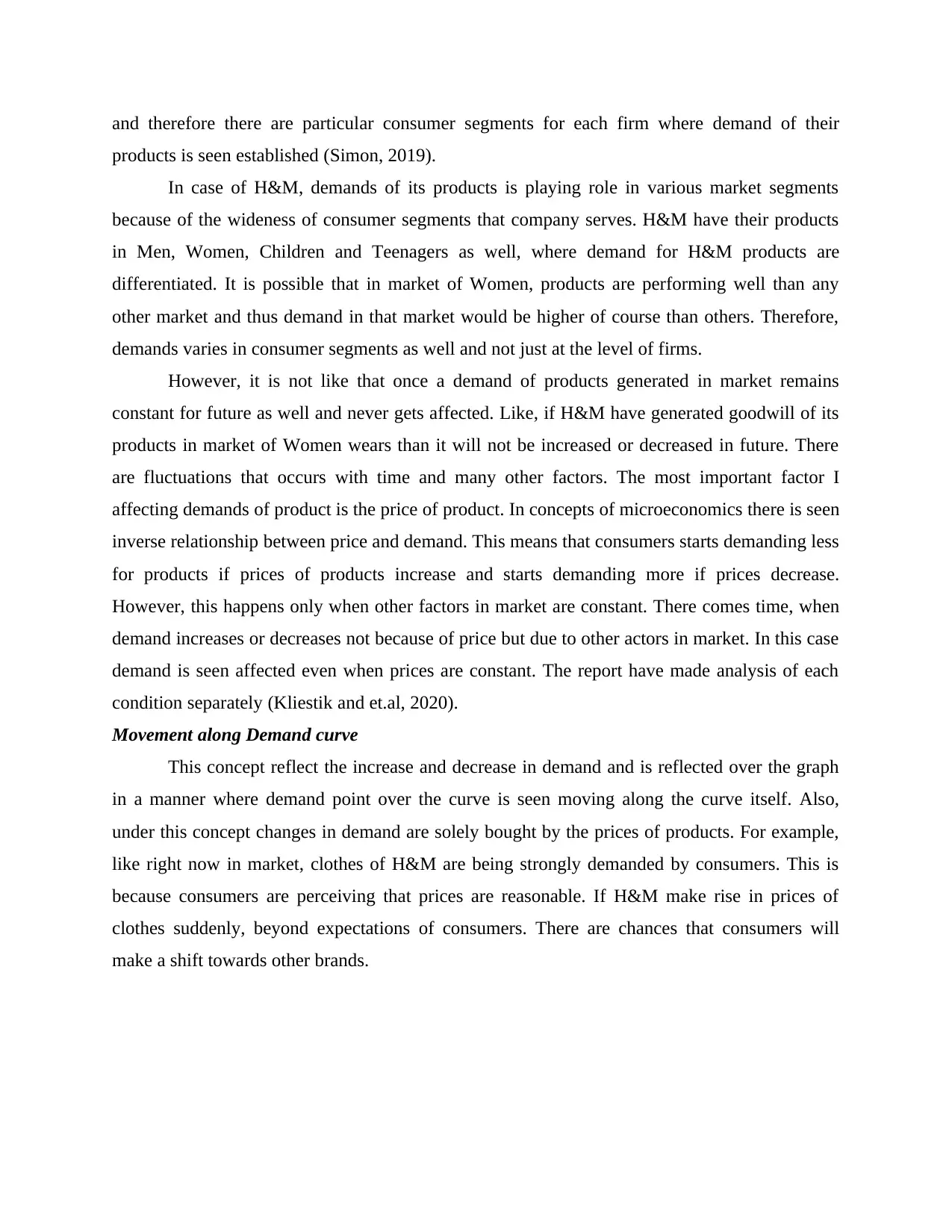
and therefore there are particular consumer segments for each firm where demand of their
products is seen established (Simon, 2019).
In case of H&M, demands of its products is playing role in various market segments
because of the wideness of consumer segments that company serves. H&M have their products
in Men, Women, Children and Teenagers as well, where demand for H&M products are
differentiated. It is possible that in market of Women, products are performing well than any
other market and thus demand in that market would be higher of course than others. Therefore,
demands varies in consumer segments as well and not just at the level of firms.
However, it is not like that once a demand of products generated in market remains
constant for future as well and never gets affected. Like, if H&M have generated goodwill of its
products in market of Women wears than it will not be increased or decreased in future. There
are fluctuations that occurs with time and many other factors. The most important factor I
affecting demands of product is the price of product. In concepts of microeconomics there is seen
inverse relationship between price and demand. This means that consumers starts demanding less
for products if prices of products increase and starts demanding more if prices decrease.
However, this happens only when other factors in market are constant. There comes time, when
demand increases or decreases not because of price but due to other actors in market. In this case
demand is seen affected even when prices are constant. The report have made analysis of each
condition separately (Kliestik and et.al, 2020).
Movement along Demand curve
This concept reflect the increase and decrease in demand and is reflected over the graph
in a manner where demand point over the curve is seen moving along the curve itself. Also,
under this concept changes in demand are solely bought by the prices of products. For example,
like right now in market, clothes of H&M are being strongly demanded by consumers. This is
because consumers are perceiving that prices are reasonable. If H&M make rise in prices of
clothes suddenly, beyond expectations of consumers. There are chances that consumers will
make a shift towards other brands.
products is seen established (Simon, 2019).
In case of H&M, demands of its products is playing role in various market segments
because of the wideness of consumer segments that company serves. H&M have their products
in Men, Women, Children and Teenagers as well, where demand for H&M products are
differentiated. It is possible that in market of Women, products are performing well than any
other market and thus demand in that market would be higher of course than others. Therefore,
demands varies in consumer segments as well and not just at the level of firms.
However, it is not like that once a demand of products generated in market remains
constant for future as well and never gets affected. Like, if H&M have generated goodwill of its
products in market of Women wears than it will not be increased or decreased in future. There
are fluctuations that occurs with time and many other factors. The most important factor I
affecting demands of product is the price of product. In concepts of microeconomics there is seen
inverse relationship between price and demand. This means that consumers starts demanding less
for products if prices of products increase and starts demanding more if prices decrease.
However, this happens only when other factors in market are constant. There comes time, when
demand increases or decreases not because of price but due to other actors in market. In this case
demand is seen affected even when prices are constant. The report have made analysis of each
condition separately (Kliestik and et.al, 2020).
Movement along Demand curve
This concept reflect the increase and decrease in demand and is reflected over the graph
in a manner where demand point over the curve is seen moving along the curve itself. Also,
under this concept changes in demand are solely bought by the prices of products. For example,
like right now in market, clothes of H&M are being strongly demanded by consumers. This is
because consumers are perceiving that prices are reasonable. If H&M make rise in prices of
clothes suddenly, beyond expectations of consumers. There are chances that consumers will
make a shift towards other brands.
Paraphrase This Document
Need a fresh take? Get an instant paraphrase of this document with our AI Paraphraser
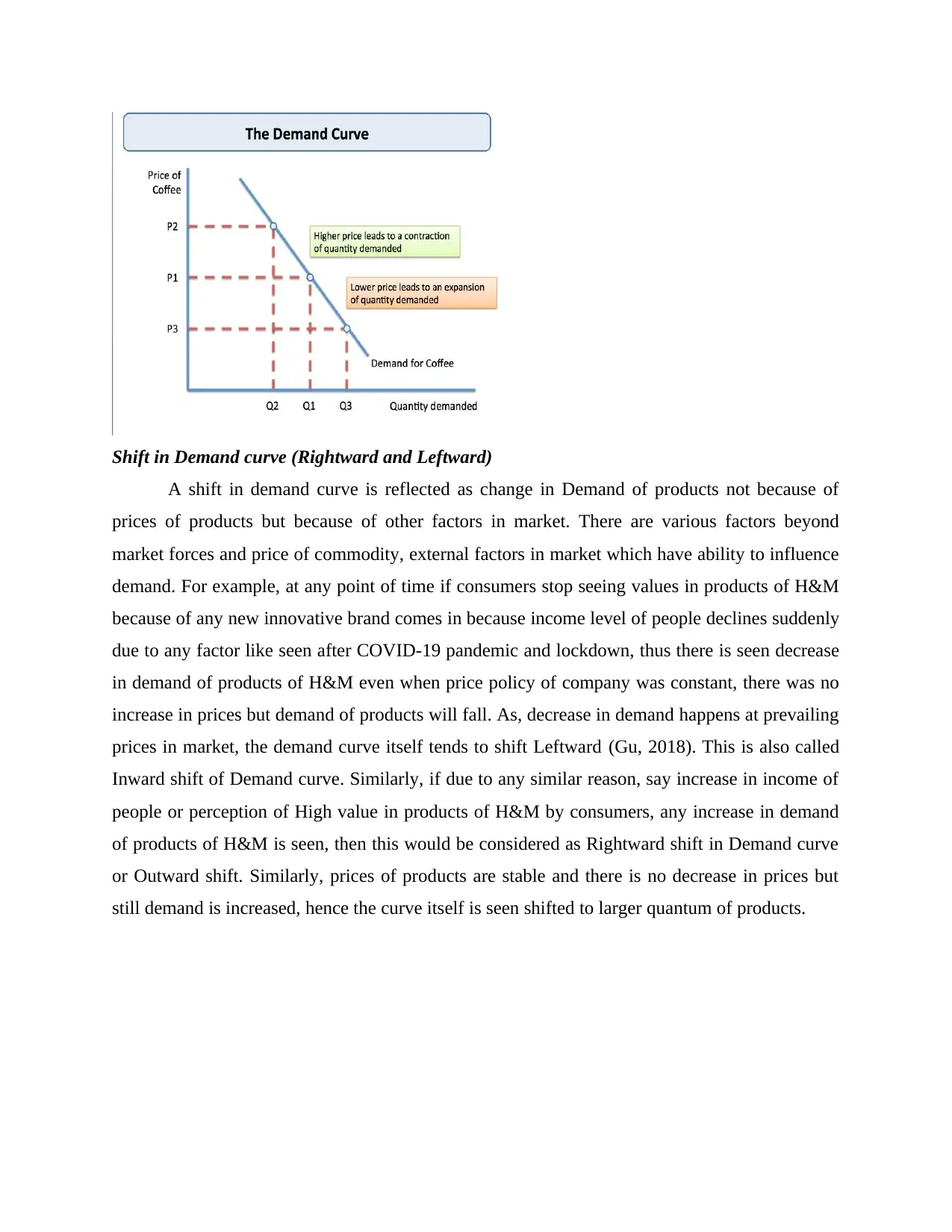
Shift in Demand curve (Rightward and Leftward)
A shift in demand curve is reflected as change in Demand of products not because of
prices of products but because of other factors in market. There are various factors beyond
market forces and price of commodity, external factors in market which have ability to influence
demand. For example, at any point of time if consumers stop seeing values in products of H&M
because of any new innovative brand comes in because income level of people declines suddenly
due to any factor like seen after COVID-19 pandemic and lockdown, thus there is seen decrease
in demand of products of H&M even when price policy of company was constant, there was no
increase in prices but demand of products will fall. As, decrease in demand happens at prevailing
prices in market, the demand curve itself tends to shift Leftward (Gu, 2018). This is also called
Inward shift of Demand curve. Similarly, if due to any similar reason, say increase in income of
people or perception of High value in products of H&M by consumers, any increase in demand
of products of H&M is seen, then this would be considered as Rightward shift in Demand curve
or Outward shift. Similarly, prices of products are stable and there is no decrease in prices but
still demand is increased, hence the curve itself is seen shifted to larger quantum of products.
A shift in demand curve is reflected as change in Demand of products not because of
prices of products but because of other factors in market. There are various factors beyond
market forces and price of commodity, external factors in market which have ability to influence
demand. For example, at any point of time if consumers stop seeing values in products of H&M
because of any new innovative brand comes in because income level of people declines suddenly
due to any factor like seen after COVID-19 pandemic and lockdown, thus there is seen decrease
in demand of products of H&M even when price policy of company was constant, there was no
increase in prices but demand of products will fall. As, decrease in demand happens at prevailing
prices in market, the demand curve itself tends to shift Leftward (Gu, 2018). This is also called
Inward shift of Demand curve. Similarly, if due to any similar reason, say increase in income of
people or perception of High value in products of H&M by consumers, any increase in demand
of products of H&M is seen, then this would be considered as Rightward shift in Demand curve
or Outward shift. Similarly, prices of products are stable and there is no decrease in prices but
still demand is increased, hence the curve itself is seen shifted to larger quantum of products.
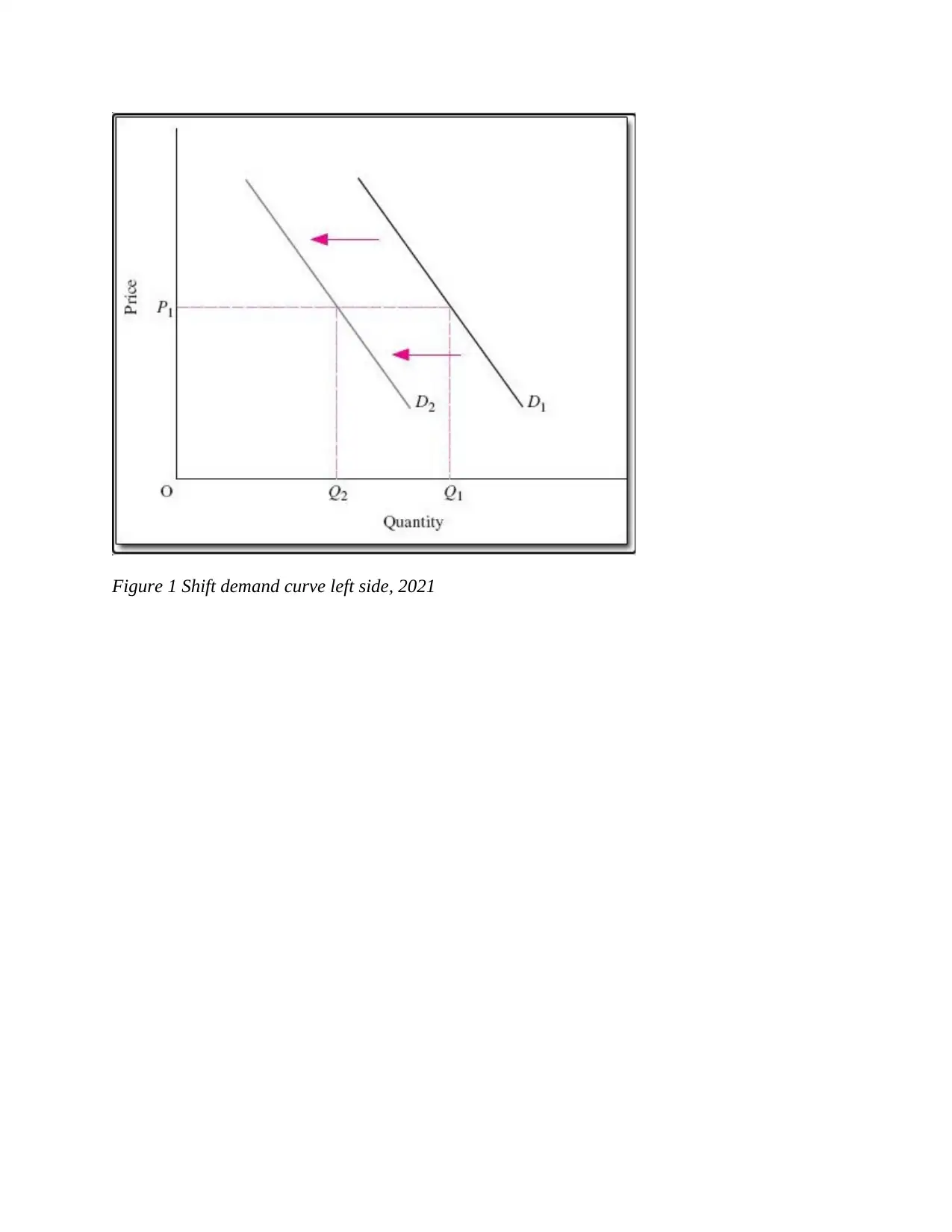
Figure 1 Shift demand curve left side, 2021
⊘ This is a preview!⊘
Do you want full access?
Subscribe today to unlock all pages.

Trusted by 1+ million students worldwide
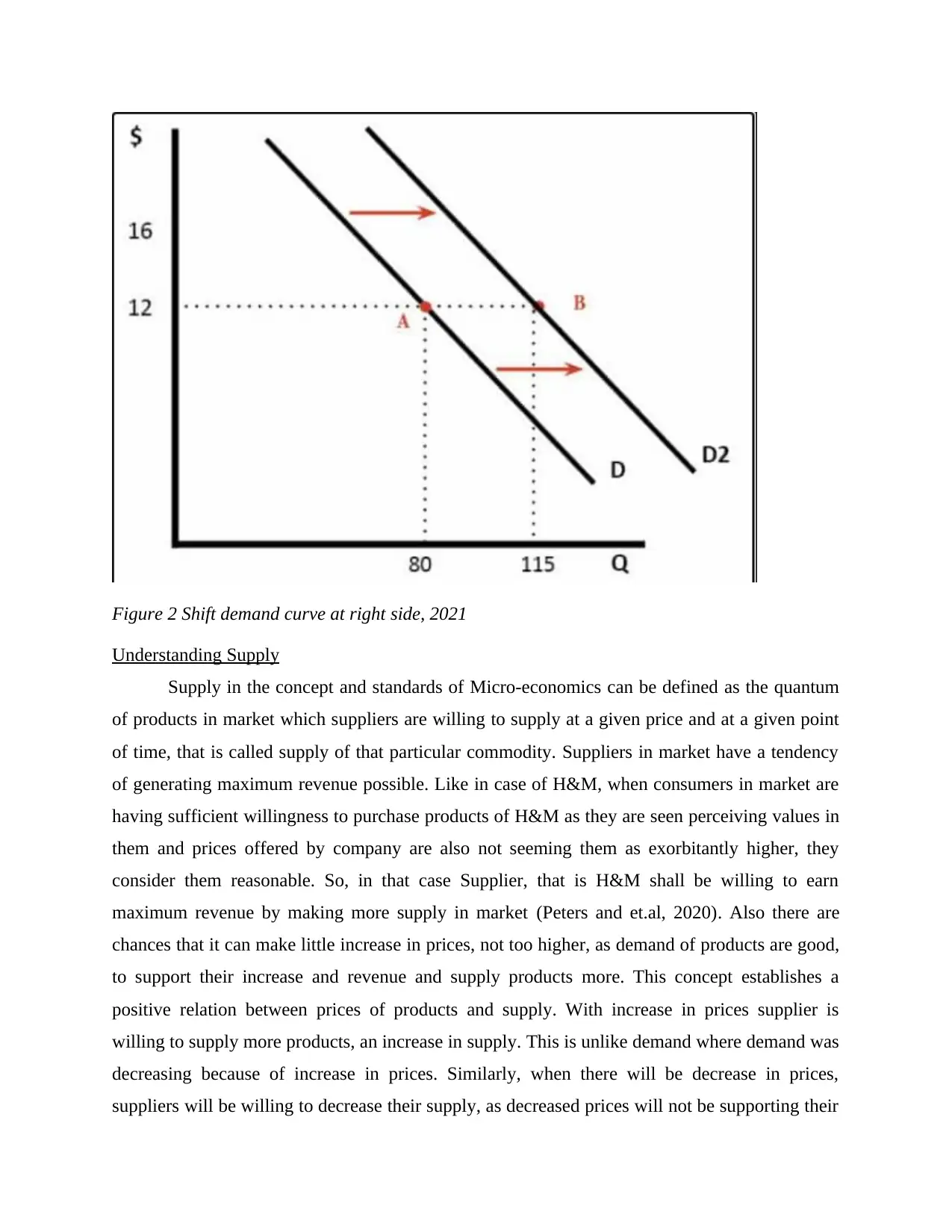
Figure 2 Shift demand curve at right side, 2021
Understanding Supply
Supply in the concept and standards of Micro-economics can be defined as the quantum
of products in market which suppliers are willing to supply at a given price and at a given point
of time, that is called supply of that particular commodity. Suppliers in market have a tendency
of generating maximum revenue possible. Like in case of H&M, when consumers in market are
having sufficient willingness to purchase products of H&M as they are seen perceiving values in
them and prices offered by company are also not seeming them as exorbitantly higher, they
consider them reasonable. So, in that case Supplier, that is H&M shall be willing to earn
maximum revenue by making more supply in market (Peters and et.al, 2020). Also there are
chances that it can make little increase in prices, not too higher, as demand of products are good,
to support their increase and revenue and supply products more. This concept establishes a
positive relation between prices of products and supply. With increase in prices supplier is
willing to supply more products, an increase in supply. This is unlike demand where demand was
decreasing because of increase in prices. Similarly, when there will be decrease in prices,
suppliers will be willing to decrease their supply, as decreased prices will not be supporting their
Understanding Supply
Supply in the concept and standards of Micro-economics can be defined as the quantum
of products in market which suppliers are willing to supply at a given price and at a given point
of time, that is called supply of that particular commodity. Suppliers in market have a tendency
of generating maximum revenue possible. Like in case of H&M, when consumers in market are
having sufficient willingness to purchase products of H&M as they are seen perceiving values in
them and prices offered by company are also not seeming them as exorbitantly higher, they
consider them reasonable. So, in that case Supplier, that is H&M shall be willing to earn
maximum revenue by making more supply in market (Peters and et.al, 2020). Also there are
chances that it can make little increase in prices, not too higher, as demand of products are good,
to support their increase and revenue and supply products more. This concept establishes a
positive relation between prices of products and supply. With increase in prices supplier is
willing to supply more products, an increase in supply. This is unlike demand where demand was
decreasing because of increase in prices. Similarly, when there will be decrease in prices,
suppliers will be willing to decrease their supply, as decreased prices will not be supporting their
Paraphrase This Document
Need a fresh take? Get an instant paraphrase of this document with our AI Paraphraser

revenue growth. The curve on which this positive relation of Supply and Price of products is
denoted on graph is called Supply curve.
However, Supply of products are also affected because of other factors as well. Factors
that are not directly reflected by market forces and supply. These are external factors beyond
market and control of suppliers, but they are also influential on supply decisions. Report have
comprehended each of this concept related to supply with help of graphical presentation (Obayi,
2018).
Movement along Supply curve
Movement along supply curve is the concept that directly reflects the relation between
Supply and Prices of products, that is a positive relationship. In case of H&M it can be said that
when company management will be increasing the demand with increase in prices of clothes and
decreasing the supply with decreasing in prices. It is where company makes its decision only
with changes in prices. Now, since both prices and quantum of supply changes simultaneously,
therefore the point of supply will be moving along the curve itself. Under this concept other
factors in market are assumed to be constant (Teece, 2019).
Shift in Supply curve
Supply curve in market, or in any particular market segment of H&M is seen making
shift when there are changes in supply decision made by management in H&M under the
influence of other factors besides market forces and prices. There are external factors present in
market which, act outside the control of management in H&M and lay down influence over its
policies these factors could be change in consumer preferences, or change in income level of
people, also there can be changes with respect to technology of production, or new business and
investment sentiments or any other factor to which firm have no option to control them but an
denoted on graph is called Supply curve.
However, Supply of products are also affected because of other factors as well. Factors
that are not directly reflected by market forces and supply. These are external factors beyond
market and control of suppliers, but they are also influential on supply decisions. Report have
comprehended each of this concept related to supply with help of graphical presentation (Obayi,
2018).
Movement along Supply curve
Movement along supply curve is the concept that directly reflects the relation between
Supply and Prices of products, that is a positive relationship. In case of H&M it can be said that
when company management will be increasing the demand with increase in prices of clothes and
decreasing the supply with decreasing in prices. It is where company makes its decision only
with changes in prices. Now, since both prices and quantum of supply changes simultaneously,
therefore the point of supply will be moving along the curve itself. Under this concept other
factors in market are assumed to be constant (Teece, 2019).
Shift in Supply curve
Supply curve in market, or in any particular market segment of H&M is seen making
shift when there are changes in supply decision made by management in H&M under the
influence of other factors besides market forces and prices. There are external factors present in
market which, act outside the control of management in H&M and lay down influence over its
policies these factors could be change in consumer preferences, or change in income level of
people, also there can be changes with respect to technology of production, or new business and
investment sentiments or any other factor to which firm have no option to control them but an
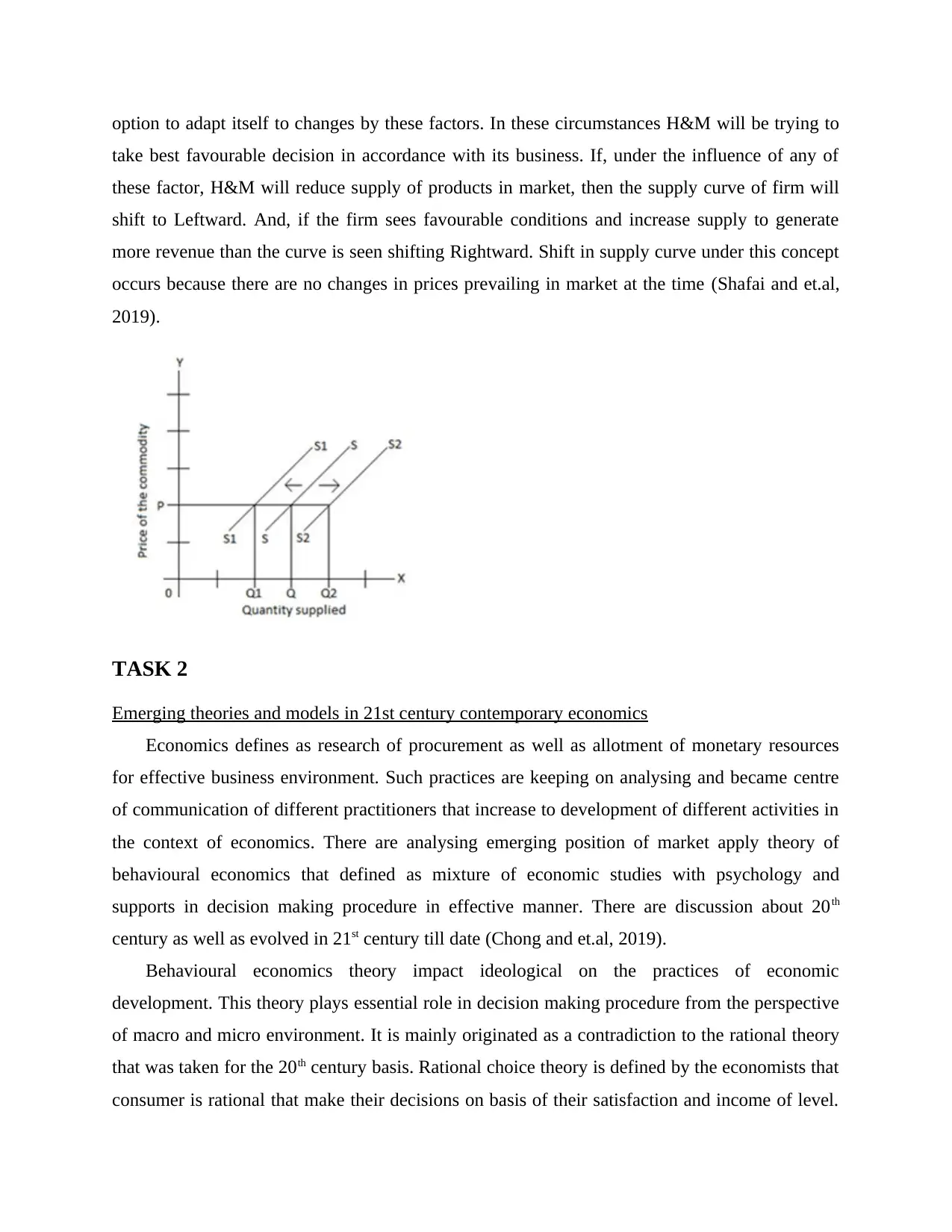
option to adapt itself to changes by these factors. In these circumstances H&M will be trying to
take best favourable decision in accordance with its business. If, under the influence of any of
these factor, H&M will reduce supply of products in market, then the supply curve of firm will
shift to Leftward. And, if the firm sees favourable conditions and increase supply to generate
more revenue than the curve is seen shifting Rightward. Shift in supply curve under this concept
occurs because there are no changes in prices prevailing in market at the time (Shafai and et.al,
2019).
TASK 2
Emerging theories and models in 21st century contemporary economics
Economics defines as research of procurement as well as allotment of monetary resources
for effective business environment. Such practices are keeping on analysing and became centre
of communication of different practitioners that increase to development of different activities in
the context of economics. There are analysing emerging position of market apply theory of
behavioural economics that defined as mixture of economic studies with psychology and
supports in decision making procedure in effective manner. There are discussion about 20th
century as well as evolved in 21st century till date (Chong and et.al, 2019).
Behavioural economics theory impact ideological on the practices of economic
development. This theory plays essential role in decision making procedure from the perspective
of macro and micro environment. It is mainly originated as a contradiction to the rational theory
that was taken for the 20th century basis. Rational choice theory is defined by the economists that
consumer is rational that make their decisions on basis of their satisfaction and income of level.
take best favourable decision in accordance with its business. If, under the influence of any of
these factor, H&M will reduce supply of products in market, then the supply curve of firm will
shift to Leftward. And, if the firm sees favourable conditions and increase supply to generate
more revenue than the curve is seen shifting Rightward. Shift in supply curve under this concept
occurs because there are no changes in prices prevailing in market at the time (Shafai and et.al,
2019).
TASK 2
Emerging theories and models in 21st century contemporary economics
Economics defines as research of procurement as well as allotment of monetary resources
for effective business environment. Such practices are keeping on analysing and became centre
of communication of different practitioners that increase to development of different activities in
the context of economics. There are analysing emerging position of market apply theory of
behavioural economics that defined as mixture of economic studies with psychology and
supports in decision making procedure in effective manner. There are discussion about 20th
century as well as evolved in 21st century till date (Chong and et.al, 2019).
Behavioural economics theory impact ideological on the practices of economic
development. This theory plays essential role in decision making procedure from the perspective
of macro and micro environment. It is mainly originated as a contradiction to the rational theory
that was taken for the 20th century basis. Rational choice theory is defined by the economists that
consumer is rational that make their decisions on basis of their satisfaction and income of level.
⊘ This is a preview!⊘
Do you want full access?
Subscribe today to unlock all pages.

Trusted by 1+ million students worldwide
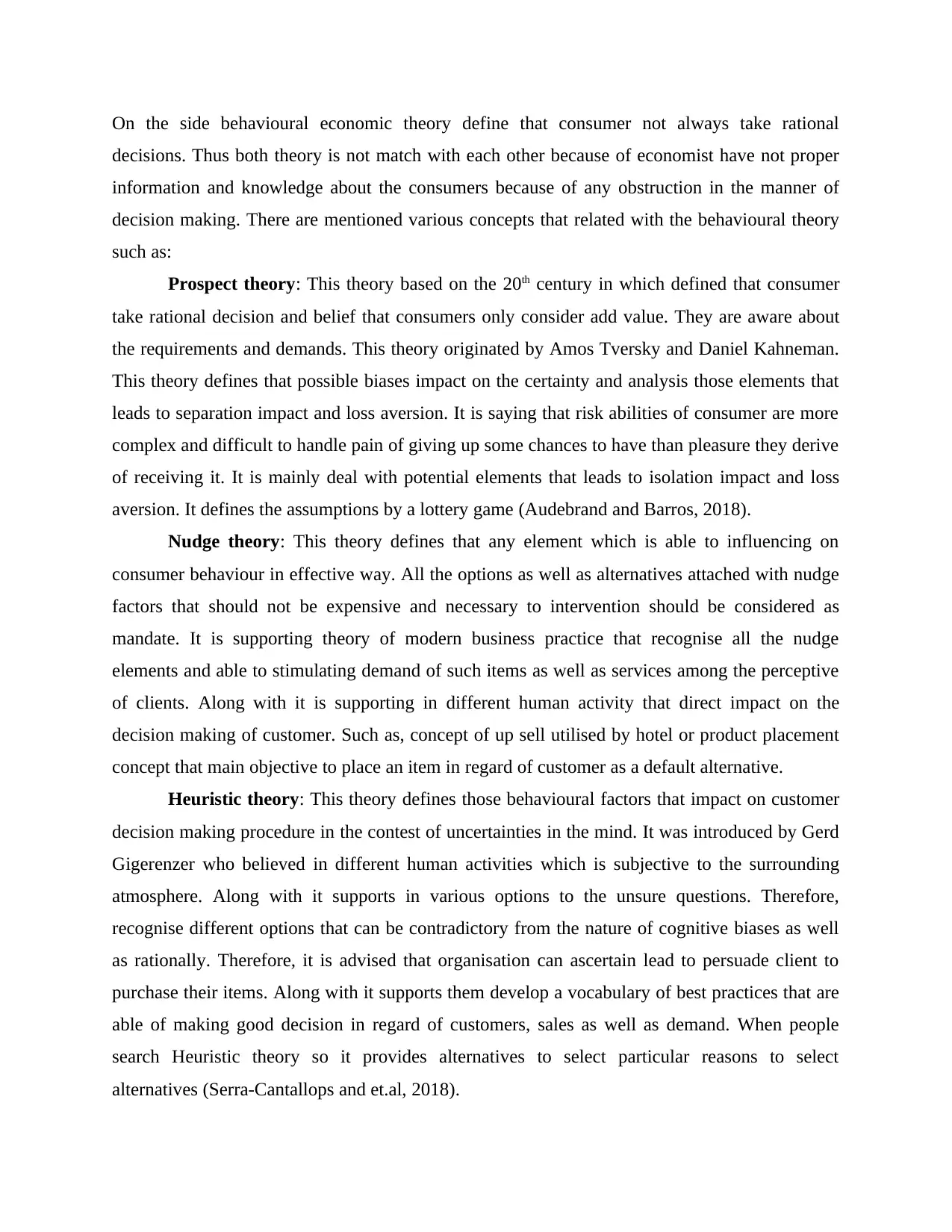
On the side behavioural economic theory define that consumer not always take rational
decisions. Thus both theory is not match with each other because of economist have not proper
information and knowledge about the consumers because of any obstruction in the manner of
decision making. There are mentioned various concepts that related with the behavioural theory
such as:
Prospect theory: This theory based on the 20th century in which defined that consumer
take rational decision and belief that consumers only consider add value. They are aware about
the requirements and demands. This theory originated by Amos Tversky and Daniel Kahneman.
This theory defines that possible biases impact on the certainty and analysis those elements that
leads to separation impact and loss aversion. It is saying that risk abilities of consumer are more
complex and difficult to handle pain of giving up some chances to have than pleasure they derive
of receiving it. It is mainly deal with potential elements that leads to isolation impact and loss
aversion. It defines the assumptions by a lottery game (Audebrand and Barros, 2018).
Nudge theory: This theory defines that any element which is able to influencing on
consumer behaviour in effective way. All the options as well as alternatives attached with nudge
factors that should not be expensive and necessary to intervention should be considered as
mandate. It is supporting theory of modern business practice that recognise all the nudge
elements and able to stimulating demand of such items as well as services among the perceptive
of clients. Along with it is supporting in different human activity that direct impact on the
decision making of customer. Such as, concept of up sell utilised by hotel or product placement
concept that main objective to place an item in regard of customer as a default alternative.
Heuristic theory: This theory defines those behavioural factors that impact on customer
decision making procedure in the contest of uncertainties in the mind. It was introduced by Gerd
Gigerenzer who believed in different human activities which is subjective to the surrounding
atmosphere. Along with it supports in various options to the unsure questions. Therefore,
recognise different options that can be contradictory from the nature of cognitive biases as well
as rationally. Therefore, it is advised that organisation can ascertain lead to persuade client to
purchase their items. Along with it supports them develop a vocabulary of best practices that are
able of making good decision in regard of customers, sales as well as demand. When people
search Heuristic theory so it provides alternatives to select particular reasons to select
alternatives (Serra-Cantallops and et.al, 2018).
decisions. Thus both theory is not match with each other because of economist have not proper
information and knowledge about the consumers because of any obstruction in the manner of
decision making. There are mentioned various concepts that related with the behavioural theory
such as:
Prospect theory: This theory based on the 20th century in which defined that consumer
take rational decision and belief that consumers only consider add value. They are aware about
the requirements and demands. This theory originated by Amos Tversky and Daniel Kahneman.
This theory defines that possible biases impact on the certainty and analysis those elements that
leads to separation impact and loss aversion. It is saying that risk abilities of consumer are more
complex and difficult to handle pain of giving up some chances to have than pleasure they derive
of receiving it. It is mainly deal with potential elements that leads to isolation impact and loss
aversion. It defines the assumptions by a lottery game (Audebrand and Barros, 2018).
Nudge theory: This theory defines that any element which is able to influencing on
consumer behaviour in effective way. All the options as well as alternatives attached with nudge
factors that should not be expensive and necessary to intervention should be considered as
mandate. It is supporting theory of modern business practice that recognise all the nudge
elements and able to stimulating demand of such items as well as services among the perceptive
of clients. Along with it is supporting in different human activity that direct impact on the
decision making of customer. Such as, concept of up sell utilised by hotel or product placement
concept that main objective to place an item in regard of customer as a default alternative.
Heuristic theory: This theory defines those behavioural factors that impact on customer
decision making procedure in the contest of uncertainties in the mind. It was introduced by Gerd
Gigerenzer who believed in different human activities which is subjective to the surrounding
atmosphere. Along with it supports in various options to the unsure questions. Therefore,
recognise different options that can be contradictory from the nature of cognitive biases as well
as rationally. Therefore, it is advised that organisation can ascertain lead to persuade client to
purchase their items. Along with it supports them develop a vocabulary of best practices that are
able of making good decision in regard of customers, sales as well as demand. When people
search Heuristic theory so it provides alternatives to select particular reasons to select
alternatives (Serra-Cantallops and et.al, 2018).
Paraphrase This Document
Need a fresh take? Get an instant paraphrase of this document with our AI Paraphraser
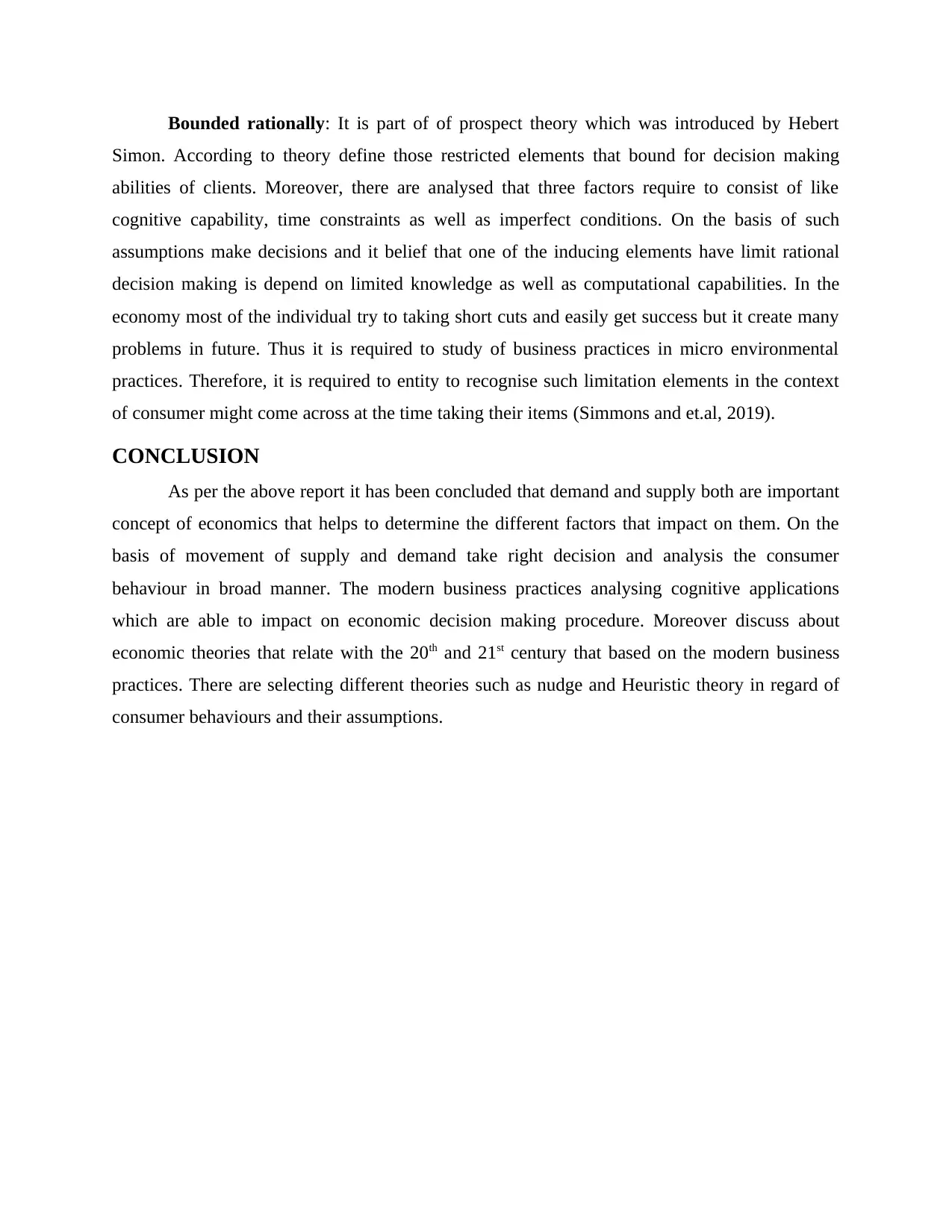
Bounded rationally: It is part of of prospect theory which was introduced by Hebert
Simon. According to theory define those restricted elements that bound for decision making
abilities of clients. Moreover, there are analysed that three factors require to consist of like
cognitive capability, time constraints as well as imperfect conditions. On the basis of such
assumptions make decisions and it belief that one of the inducing elements have limit rational
decision making is depend on limited knowledge as well as computational capabilities. In the
economy most of the individual try to taking short cuts and easily get success but it create many
problems in future. Thus it is required to study of business practices in micro environmental
practices. Therefore, it is required to entity to recognise such limitation elements in the context
of consumer might come across at the time taking their items (Simmons and et.al, 2019).
CONCLUSION
As per the above report it has been concluded that demand and supply both are important
concept of economics that helps to determine the different factors that impact on them. On the
basis of movement of supply and demand take right decision and analysis the consumer
behaviour in broad manner. The modern business practices analysing cognitive applications
which are able to impact on economic decision making procedure. Moreover discuss about
economic theories that relate with the 20th and 21st century that based on the modern business
practices. There are selecting different theories such as nudge and Heuristic theory in regard of
consumer behaviours and their assumptions.
Simon. According to theory define those restricted elements that bound for decision making
abilities of clients. Moreover, there are analysed that three factors require to consist of like
cognitive capability, time constraints as well as imperfect conditions. On the basis of such
assumptions make decisions and it belief that one of the inducing elements have limit rational
decision making is depend on limited knowledge as well as computational capabilities. In the
economy most of the individual try to taking short cuts and easily get success but it create many
problems in future. Thus it is required to study of business practices in micro environmental
practices. Therefore, it is required to entity to recognise such limitation elements in the context
of consumer might come across at the time taking their items (Simmons and et.al, 2019).
CONCLUSION
As per the above report it has been concluded that demand and supply both are important
concept of economics that helps to determine the different factors that impact on them. On the
basis of movement of supply and demand take right decision and analysis the consumer
behaviour in broad manner. The modern business practices analysing cognitive applications
which are able to impact on economic decision making procedure. Moreover discuss about
economic theories that relate with the 20th and 21st century that based on the modern business
practices. There are selecting different theories such as nudge and Heuristic theory in regard of
consumer behaviours and their assumptions.
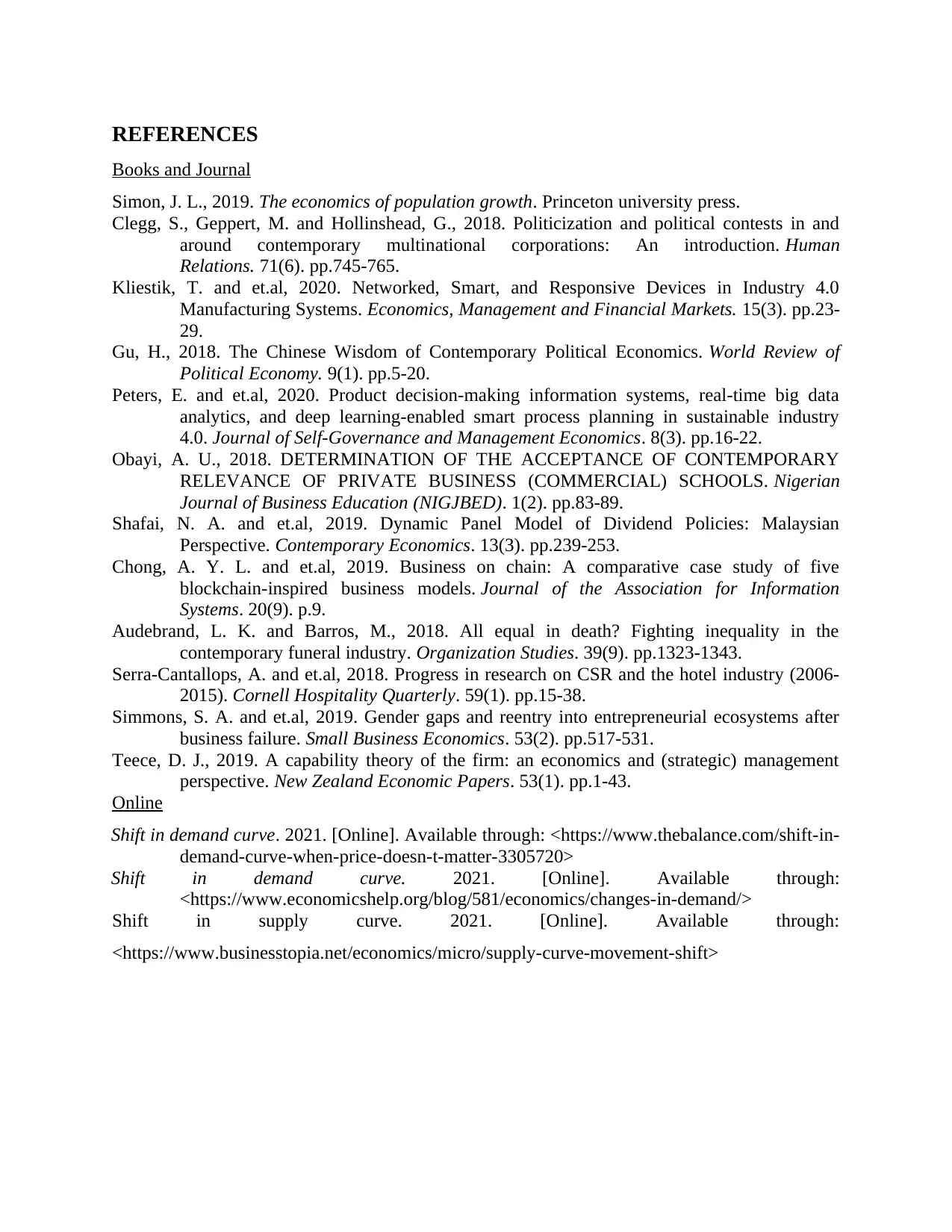
REFERENCES
Books and Journal
Simon, J. L., 2019. The economics of population growth. Princeton university press.
Clegg, S., Geppert, M. and Hollinshead, G., 2018. Politicization and political contests in and
around contemporary multinational corporations: An introduction. Human
Relations. 71(6). pp.745-765.
Kliestik, T. and et.al, 2020. Networked, Smart, and Responsive Devices in Industry 4.0
Manufacturing Systems. Economics, Management and Financial Markets. 15(3). pp.23-
29.
Gu, H., 2018. The Chinese Wisdom of Contemporary Political Economics. World Review of
Political Economy. 9(1). pp.5-20.
Peters, E. and et.al, 2020. Product decision-making information systems, real-time big data
analytics, and deep learning-enabled smart process planning in sustainable industry
4.0. Journal of Self-Governance and Management Economics. 8(3). pp.16-22.
Obayi, A. U., 2018. DETERMINATION OF THE ACCEPTANCE OF CONTEMPORARY
RELEVANCE OF PRIVATE BUSINESS (COMMERCIAL) SCHOOLS. Nigerian
Journal of Business Education (NIGJBED). 1(2). pp.83-89.
Shafai, N. A. and et.al, 2019. Dynamic Panel Model of Dividend Policies: Malaysian
Perspective. Contemporary Economics. 13(3). pp.239-253.
Chong, A. Y. L. and et.al, 2019. Business on chain: A comparative case study of five
blockchain-inspired business models. Journal of the Association for Information
Systems. 20(9). p.9.
Audebrand, L. K. and Barros, M., 2018. All equal in death? Fighting inequality in the
contemporary funeral industry. Organization Studies. 39(9). pp.1323-1343.
Serra-Cantallops, A. and et.al, 2018. Progress in research on CSR and the hotel industry (2006-
2015). Cornell Hospitality Quarterly. 59(1). pp.15-38.
Simmons, S. A. and et.al, 2019. Gender gaps and reentry into entrepreneurial ecosystems after
business failure. Small Business Economics. 53(2). pp.517-531.
Teece, D. J., 2019. A capability theory of the firm: an economics and (strategic) management
perspective. New Zealand Economic Papers. 53(1). pp.1-43.
Online
Shift in demand curve. 2021. [Online]. Available through: <https://www.thebalance.com/shift-in-
demand-curve-when-price-doesn-t-matter-3305720>
Shift in demand curve. 2021. [Online]. Available through:
<https://www.economicshelp.org/blog/581/economics/changes-in-demand/>
Shift in supply curve. 2021. [Online]. Available through:
<https://www.businesstopia.net/economics/micro/supply-curve-movement-shift>
Books and Journal
Simon, J. L., 2019. The economics of population growth. Princeton university press.
Clegg, S., Geppert, M. and Hollinshead, G., 2018. Politicization and political contests in and
around contemporary multinational corporations: An introduction. Human
Relations. 71(6). pp.745-765.
Kliestik, T. and et.al, 2020. Networked, Smart, and Responsive Devices in Industry 4.0
Manufacturing Systems. Economics, Management and Financial Markets. 15(3). pp.23-
29.
Gu, H., 2018. The Chinese Wisdom of Contemporary Political Economics. World Review of
Political Economy. 9(1). pp.5-20.
Peters, E. and et.al, 2020. Product decision-making information systems, real-time big data
analytics, and deep learning-enabled smart process planning in sustainable industry
4.0. Journal of Self-Governance and Management Economics. 8(3). pp.16-22.
Obayi, A. U., 2018. DETERMINATION OF THE ACCEPTANCE OF CONTEMPORARY
RELEVANCE OF PRIVATE BUSINESS (COMMERCIAL) SCHOOLS. Nigerian
Journal of Business Education (NIGJBED). 1(2). pp.83-89.
Shafai, N. A. and et.al, 2019. Dynamic Panel Model of Dividend Policies: Malaysian
Perspective. Contemporary Economics. 13(3). pp.239-253.
Chong, A. Y. L. and et.al, 2019. Business on chain: A comparative case study of five
blockchain-inspired business models. Journal of the Association for Information
Systems. 20(9). p.9.
Audebrand, L. K. and Barros, M., 2018. All equal in death? Fighting inequality in the
contemporary funeral industry. Organization Studies. 39(9). pp.1323-1343.
Serra-Cantallops, A. and et.al, 2018. Progress in research on CSR and the hotel industry (2006-
2015). Cornell Hospitality Quarterly. 59(1). pp.15-38.
Simmons, S. A. and et.al, 2019. Gender gaps and reentry into entrepreneurial ecosystems after
business failure. Small Business Economics. 53(2). pp.517-531.
Teece, D. J., 2019. A capability theory of the firm: an economics and (strategic) management
perspective. New Zealand Economic Papers. 53(1). pp.1-43.
Online
Shift in demand curve. 2021. [Online]. Available through: <https://www.thebalance.com/shift-in-
demand-curve-when-price-doesn-t-matter-3305720>
Shift in demand curve. 2021. [Online]. Available through:
<https://www.economicshelp.org/blog/581/economics/changes-in-demand/>
Shift in supply curve. 2021. [Online]. Available through:
<https://www.businesstopia.net/economics/micro/supply-curve-movement-shift>
⊘ This is a preview!⊘
Do you want full access?
Subscribe today to unlock all pages.

Trusted by 1+ million students worldwide
1 out of 12
Related Documents
Your All-in-One AI-Powered Toolkit for Academic Success.
+13062052269
info@desklib.com
Available 24*7 on WhatsApp / Email
![[object Object]](/_next/static/media/star-bottom.7253800d.svg)
Unlock your academic potential
Copyright © 2020–2026 A2Z Services. All Rights Reserved. Developed and managed by ZUCOL.





